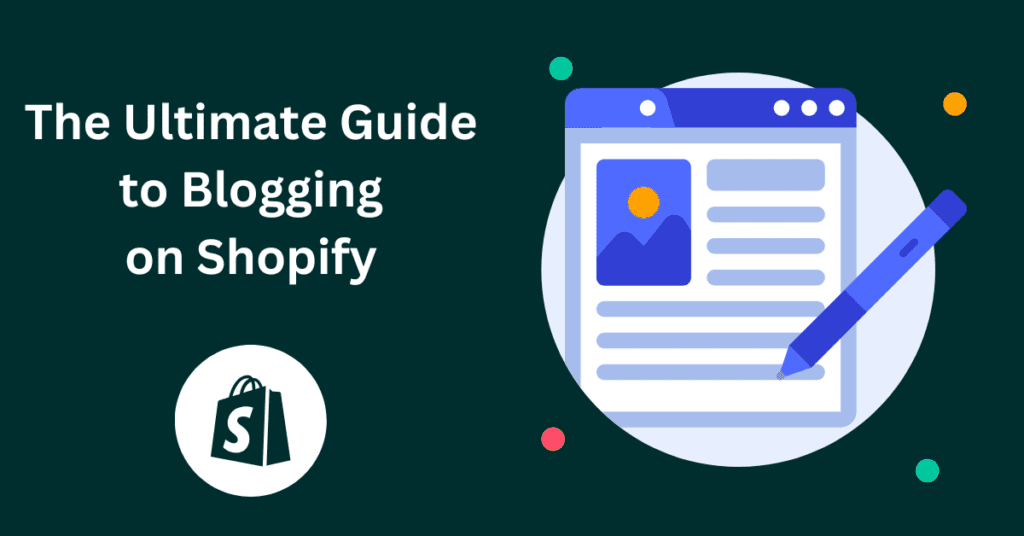Introduction
In the fast-paced and ever-evolving world of e-commerce, finding new ways to drive customer engagement, increase sales, and differentiate your brand is critical. One such method that has demonstrated significant potential is blogging, particularly blogging on Shopify. As one of the world’s leading e-commerce platforms, Shopify provides businesses with an integrated solution for selling products, and its blogging feature is a powerful, yet often underutilized tool. By creating compelling blog content, businesses can enhance their brand story, improve their SEO rankings, build customer loyalty, and ultimately, drive higher conversion rates.
However, to fully harness the benefits of blogging on Shopify, it’s crucial to have a solid understanding of how to set up a blog, generate effective content, integrate it with your online store, and track its performance. And that’s precisely the purpose of this article. In the following sections, we will provide you with an ultimate guide to blogging on Shopify, packed with practical strategies and tips to help you optimize your blog and maximize your e-commerce potential.
Whether you’re just starting out or looking to refine your existing blogging approach, this guide aims to empower you with the knowledge and tools you need to take your Shopify blogging to the next level.

Table of Contents
Understanding the Power of Blogging on Shopify
Before we delve into the strategies and tactics of blogging on Shopify, it’s essential to understand what it truly means and why it holds such considerable significance in the e-commerce space.
Blogging on Shopify refers to the practice of creating, publishing, and promoting informative and engaging blog content on your Shopify store’s website. This feature is an integral part of Shopify’s all-in-one platform, designed to help businesses seamlessly merge e-commerce operations with content marketing strategies. The aim is to enhance the shopping experience, provide value to your customers, and ultimately, boost your e-commerce sales.
But why does blogging on Shopify matter? The answer lies in the powerful impact that quality content can have on customer engagement and sales. Here’s a look at some statistics to illustrate this:
According to a study by HubSpot, businesses that prioritize blogging efforts are 13 times more likely to see positive ROI. By leveraging the Shopify platform, these businesses can create a centralized shopping and reading experience, which can enhance the potential for conversions.
Content marketing, which includes blogging, gets three times more leads than paid search advertising, according to a report by the Content Marketing Institute. With the right SEO strategies in place, your Shopify blog can significantly increase organic traffic to your store.
A consumer survey by Demand Gen Report found that 47% of buyers view three to five pieces of content before making a purchase. By blogging on Shopify, you can provide this necessary content to potential buyers, influencing their purchase decisions and establishing your brand as a trusted authority in your niche.
These statistics underscore the power of blogging on Shopify. It’s not just about selling; it’s about building a community around your brand, educating your customers, and providing value that goes beyond the products or services you offer. By doing so, you can maximize your e-commerce potential and foster sustainable growth.
Setting Up Your Shopify Blog
Now that we’ve established the importance of blogging on Shopify, let’s delve into the practical steps of setting up your blog. A well-structured blog is fundamental to creating a seamless user experience, improving your SEO, and effectively communicating your brand message.
Step 1: Navigate to the Blog Section
Log into your Shopify admin dashboard, then click on “Online Store,” and select “Blog Posts.” From here, you can manage your existing blog posts or create a new one.
Step 2: Create a New Blog
Click on “Manage blogs” and then “Add blog”. This is where you create your blog and give it a name. Ensure that the blog’s name resonates with your brand and gives an indication of the type of content you’ll be sharing.
Step 3: Set Up Your Blog
There are a few settings you need to adjust before publishing your blog. Choose your commenting policy, whether you want to manually approve comments or disable them entirely. Also, consider your SEO settings – add a meta description that effectively summarizes your blog’s content.
Step 4: Write Your First Blog Post
Once your blog is set up, you can begin crafting your first blog post. Click on “Add blog post” and you’ll be taken to a new page where you can input your title, content, and author information.
Step 5: Optimize Your Blog Post
Before you hit publish, optimize your post for SEO by adding relevant tags, adjusting the URL and handle, and creating a compelling meta description. This is crucial for improving your visibility on search engines and driving organic traffic to your store.
Step 6: Publish Your Blog Post
Once you’re satisfied with your blog post, click on “Save” and then “Publish.” Your blog post will now be live and accessible to your audience.
Remember, the setup process doesn’t end with publishing your first blog post. Regular maintenance, consistent posting, and ongoing optimization are crucial for maximizing the potential of blogging on Shopify. This includes responding to comments, updating your blog design to stay consistent with your branding, and routinely checking your SEO settings to ensure your blog posts are easily discoverable. Proper setup and maintenance serve as the foundation of a successful Shopify blog.
Crafting Effective Content: Blogging on Shopify
High-quality content is the lifeblood of any successful blog, and blogging on Shopify is no exception. Creating compelling, valuable, and engaging content not only draws visitors to your site but also fosters customer loyalty and boosts sales by establishing your brand as a trusted authority in your niche.
Here are some tips and strategies to help you craft effective blog content for your Shopify store:
Understand Your Audience: Before you start writing, take the time to understand who your audience is, what they’re interested in, and what problems they’re looking to solve. This understanding will inform the topics you choose, the tone of your writing, and the type of content you produce.
Create Valuable Content: Your blog should provide real value to your readers. This could be in the form of how-to guides, industry news, product reviews, or tips and advice. The key is to offer something that your audience can benefit from.
Focus on SEO: Use relevant keywords in your blog posts to improve their visibility on search engine results pages. However, don’t overdo it. Google prioritizes content that is written for humans, not search engines, so always maintain a natural writing style.
Incorporate Visuals: Use relevant images, infographics, and videos in your posts to break up the text and make your content more engaging. Visuals also help to convey your message more effectively.
Include a Call to Action: Each post should have a clear call to action. Whether it’s encouraging readers to purchase a product, sign up for your newsletter, or share your content on social media, make sure you guide your audience on what to do next.
To understand the power of well-crafted blog content, let’s look at a couple of case studies:
Case Study 1: Beardbrand, a men’s grooming company, used their Shopify blog to share grooming tips and advice, product reviews, and personal stories. By offering value beyond their products, they were able to build a strong community around their brand and significantly increase their sales.
Case Study 2: Gymshark, a fitness apparel brand, used their Shopify blog to share workout guides, nutrition advice, and athlete interviews. This strategy helped them establish themselves as a go-to resource in the fitness community, increasing their site traffic and customer loyalty, which in turn boosted their e-commerce performance.
Both of these examples highlight the power of blogging on Shopify. By creating high-quality content that resonates with your audience, you can maximize your e-commerce potential and set your brand up for long-term success.
Integrating Your Blog with Your Shopify Store
Integrating your blog with your Shopify store is key to creating a seamless shopping experience for your customers. It allows your customers to effortlessly transition between learning about your products and making a purchase, which can significantly boost your sales and customer engagement.
Here are some strategies to seamlessly incorporate your blog into your Shopify storefront:
1. Make Your Blog Easily Accessible: Ensure your blog is easy to find from any page on your website. This could be through a dedicated ‘Blog’ link in your main navigation menu or highlighted sections on your homepage featuring recent or popular blog posts.
2. Interlink Between Product Pages and Blog Posts: When writing blog posts, link to your products where relevant. Similarly, on product pages, you can link to blog posts that feature or discuss the product in more detail. This encourages customers to navigate between your blog and product pages, increasing their engagement with your store.
3. Showcase Your Blog in Email Newsletters: If you have a mailing list, include snippets or links from your blog in your newsletters. This can drive traffic to both your blog and your product pages.
4. Use Social Media to Promote Your Blog: Sharing your blog posts on social media is a great way to direct your followers to your Shopify store. You can also encourage your readers to share your blog posts on their social media platforms, further increasing your store’s visibility.
Integrating your blog with your Shopify store not only enhances the customer experience but also boosts your store’s SEO performance. The increased interlinking can help search engines understand the structure and content of your site better, leading to improved search rankings. Furthermore, by providing valuable, relevant content through your blog, you increase the chances of your audience spending more time on your store and coming back for more, both of which are beneficial for your Shopify store’s SEO.
In essence, integrating your blog with your Shopify store enables you to provide your audience with a more enriching and engaging shopping experience. This, in turn, can help you maximize your customer engagement, boost your sales, and take full advantage of the benefits of blogging on Shopify.
Maximizing Blog Visibility through SEO and Social Media
In the world of blogging, creating great content is just half the battle won. The other half involves making sure your content is seen by your target audience. Two powerful tools at your disposal for achieving this are Search Engine Optimization (SEO) and social media.
Understanding SEO and Its Importance in Blogging on Shopify
SEO involves optimizing your website and content to rank higher on search engine results pages (SERPs), making it more visible to people who are searching for information related to your brand, products, or industry.
Effective SEO can significantly increase the reach of your Shopify blog. By ranking higher on SERPs, your blog can attract more organic traffic, potentially leading to increased customer engagement and sales. It’s also a cost-effective strategy, as it doesn’t require any paid advertising to drive traffic.
Here are some key SEO principles to keep in mind when blogging on Shopify:
Keyword Optimization: Include relevant keywords in your blog posts. These are words or phrases that your target audience is likely to use when searching for information online. Include them in your post’s title, headings, body text, and meta description.
High-Quality Content: Search engines prioritize content that is unique, valuable, and engaging. Consistently producing high-quality blog posts can improve your SEO rankings over time.
Meta Descriptions: A meta description is the snippet of information that appears below the link of a search result. It should be concise, compelling, and include your main keywords.
Mobile Optimization: Ensure your blog is mobile-friendly. With more people browsing the web on their mobile devices, search engines now prioritize mobile-optimized websites.
Leveraging Social Media to Amplify Your Shopify Blog’s Reach
Social media platforms are excellent channels for promoting your Shopify blog and reaching a wider audience. They allow you to engage directly with your customers, share your content with a larger community, and drive traffic back to your Shopify store.
Here are some tips on using social media to amplify the reach of your Shopify blog:
Share Your Blog Posts: Every time you publish a new blog post, share it on all your social media platforms. You can even share it multiple times by highlighting different sections of the post.
Engage with Your Audience: Don’t just post your content and forget about it. Engage with your followers by responding to comments, asking questions, and encouraging discussions.
Use Relevant Hashtags: Hashtags can help boost the visibility of your posts, making them discoverable to people who don’t follow you but are interested in your content.
Collaborate with Influencers: Partnering with influencers in your industry can help expose your blog to a larger audience. They can share your content or write guest posts for your blog.
By implementing these SEO and social media strategies, you can significantly increase the visibility of your Shopify blog, attract more traffic to your store, and ultimately, maximize your e-commerce potential.
Tracking and Improving Your Shopify Blog’s Performance
Once you’ve established your Shopify blog and started generating content, it’s crucial to monitor its performance and make adjustments where necessary. By tracking key metrics, you can gain insights into what’s working, what isn’t, and how you can optimize your blog to maximize your e-commerce potential.
Key Metrics for Assessing the Effectiveness of Blogging on Shopify
Traffic: Monitor the number of visitors to your blog. Are you attracting new visitors? Is your audience growing over time?
Engagement: Look at how users are interacting with your blog. Are they spending time reading your content? Are they leaving comments or sharing your posts on social media?
Conversion Rate: This is perhaps the most critical metric for an e-commerce business. Are your blog readers turning into customers? Are they clicking through to your product pages and making purchases?
Bounce Rate: The bounce rate is the percentage of visitors who leave your website after viewing only one page. A high bounce rate may indicate that your content isn’t engaging enough to keep visitors on your site.
SEO Ranking: Where do your blog posts rank on search engine results pages for your target keywords? High rankings can lead to increased organic traffic.
Using Shopify’s Analytic Tools to Track Blog Performance
Shopify provides a range of analytics tools that can help you track these metrics and gain insights into your blog’s performance:
Shopify Analytics: This feature provides you with a comprehensive overview of your online store’s performance. You can track the number of visits to your blog, where your traffic is coming from, and how many visitors are converting into customers.
Google Analytics: You can integrate Google Analytics with your Shopify store to gain more in-depth insights into your blog’s performance. This tool allows you to track user behavior, such as how long visitors stay on your blog and what they do while they’re there.
SEO Tools: Shopify’s SEO tools can help you optimize your blog posts for search engines and track your SEO performance. You can also use tools like Google’s Keyword Planner to identify potential keywords for your blog posts.
By regularly tracking these metrics and using Shopify’s analytic tools, you can make data-driven decisions about your blog content and strategy, continually improving your blog’s performance, and leveraging the power of blogging on Shopify to its fullest potential.
Success Stories: Profiting from Blogging on Shopify
Blogging on Shopify has proven to be a successful strategy for many businesses looking to boost their e-commerce potential. Let’s take a closer look at a few real-life examples of companies that have harnessed the power of Shopify’s blogging platform to enhance their brand, engage their customers, and increase their sales.
Allbirds: Allbirds, a sustainable shoe brand, has effectively used their Shopify blog to educate their customers about their eco-friendly products and practices. Their blog posts feature in-depth information about their materials, manufacturing processes, and sustainability efforts. This transparency has helped them build trust and loyalty among their customer base, ultimately leading to increased sales.
Pipsnacks: Pipsnacks, a snack company, uses their Shopify blog to share recipe ideas, announce new products, and showcase customer testimonials. Their engaging and relevant content has attracted a loyal following, driving significant traffic to their Shopify store and boosting their e-commerce performance.
Biko: Biko, a jewelry brand, uses their Shopify blog to showcase their products, share styling tips, and highlight press features. By integrating their blog with their online store, they’ve created a seamless shopping experience for their customers, leading to increased engagement and sales.
MVMT Watches: MVMT uses their Shopify blog to tell their brand story, share lifestyle content, and highlight customer experiences. Their high-quality, visually appealing content reinforces their brand identity, drives significant traffic to their store, and increases customer loyalty.
These success stories demonstrate the powerful impact of blogging on Shopify. By providing valuable content, engaging with their customers, and integrating their blogs with their Shopify stores, these businesses have been able to maximize their e-commerce potential and achieve significant success.
Conclusion
In the world of e-commerce, staying competitive means not only offering excellent products but also creating engaging, valuable content that resonates with your customers. This is where blogging on Shopify comes into play. As we’ve explored in this guide, a well-executed blog on your Shopify store can significantly boost your customer engagement, improve your SEO performance, and ultimately, maximize your e-commerce potential.
Whether you’re a seasoned e-commerce business looking to improve your blogging strategy or a budding entrepreneur just starting out on Shopify, we hope this guide has provided you with valuable insights and practical tips to succeed in your blogging journey.
Remember, effective blogging on Shopify is not about quick wins but consistent, long-term efforts. From setting up your blog and crafting compelling content to integrating your blog with your Shopify store, promoting it through SEO and social media, and tracking its performance, each step plays a crucial role in your overall success.
In the end, the benefits of blogging on Shopify can be tremendous. Not only can it drive traffic and sales, but it can also help you build a loyal community around your brand. As showcased by the success stories, it’s indeed possible to significantly boost your e-commerce potential through strategic blogging on Shopify.
So, get started or optimize your blogging journey on Shopify today. The road to maximizing your e-commerce potential begins with a single blog post. Happy blogging!
Frequently Asked Questions
Is Shopify good for blogging?
Yes, Shopify is good for blogging. It offers a built-in blogging platform that allows you to easily create and manage blog posts. It's a great tool for enhancing your content marketing strategy, improving your SEO, and engaging with your customers, all of which can contribute to the success of your e-commerce store.
Can you make money from a Shopify blog?
Yes, you can make money from a Shopify blog indirectly. While Shopify does not have a built-in mechanism for monetizing a blog through ads or paid content, a well-maintained blog can contribute to increased traffic, customer engagement, and brand awareness. This can lead to higher sales and revenue for your Shopify store.
Which platform is best for blogging?
The best platform for blogging depends on your needs and objectives. If you're running an e-commerce store, Shopify is an excellent choice because it combines commerce and blogging in one platform. WordPress is another excellent option, especially if you're focused primarily on content creation. It offers robust blogging features and endless customization options.
Is blogging good for eCommerce?
Yes, blogging is great for e-commerce. It can help to drive traffic to your store, improve your SEO rankings, educate your customers about your products, and build a community around your brand. All of these can lead to increased sales and customer loyalty.
Is Shopify blog free?
Yes, the blogging feature is included in all Shopify plans at no additional cost. However, keep in mind that Shopify itself is a paid platform with different plans to suit various business needs.
Is Shopify blog SEO friendly?
Yes, Shopify's blog is SEO-friendly. It offers SEO features like customizable H1, title, and meta tags. It also allows you to create a sitemap.xml automatically, which helps Google and other search engines to crawl and index your site. Furthermore, you can enhance your SEO performance by creating high-quality, relevant blog content and following SEO best practices.







